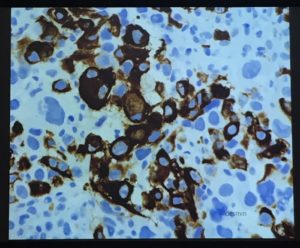So your kid has a lump, a bump or a mass and the doctor says that they need to take a biopsy (small sample of it) to determine what it is. Cue anxiety right? Then the doctor says the result can take anywhere from 2-10 business days to get a result. What the what!? Why on Earth does this take so long in the year 2018? Well there’s a few reasons and I’ll talk about one a little in depth today.
The pathologists (doctors who look at the tissue and make the diagnosis) rely on many different characteristics to make an accurate diagnosis. The list of ‘characteristics’ is ever growing the more we know about cancer and especially the genetics of cancer. Overall this is a good thing because we now know that some cancers we used lump into a single category can now be split into different types subtypes. This allows us to treat the patient more precisely and accurately.
One method of looking at cancer cells is to look at the proteins that are expressed on the outside and the inside of the cell. This is done through a process called immunohistochemistry (IHC). Cancers can have characteristic patterns of expression in the types of proteins they express and the where they are expressed. Through IHC, the pathologists can look at these patterns.
Below is a diagram of IHC. In a nutshell, the biopsy is sliced very thinly and fixed to a microscope slide. An antibody that recognizes a certain protein is added to the slide and if the protein is present, the antibody will attach to it. A secondary antibody is then added to the slide which recognizes the first antibody but the secondary antibody also has color attached to it so that we can visualize it. This indirect method of using two antibodies increases the overall sensitivity of the test.
This process of adding antibodies and letting them soak can take hours to a full day. In addition, the choice of antibodies to use is generally dictated in sequence ( ie. if Protein A is positive, move on to Protein B. If Protein A is negative, move on to Protein C). For diagnostically challenging cases, there many many stains that are done and this can be a lengthy process.
Here is an example of some IHC of one tumor we discussed recently. This is all the same biopsy specimen of sarcoma.



Isn’t science cool?

